The Gokhale Method Around the World: Canberra, Australia, with Tegan Kahn
Since the pandemic we are delighted to have resumed teacher training and welcomed 12 new teachers to the Gokhale Method community in Europe and the U.S. We are also steadily growing our roots in the Southern Hemisphere. Below, Australia-based Teacher Tegan Kahn shares the story of how and why she decided to train.
One New Year’s Day many years ago, I made a resolution to “have better posture.” This was back before I had kids; when I had time and energy to devote to grand plans! But, like most New Year’s Resolutions, it fizzled out pretty quickly. For several days, I reminded myself every hour to sit up straight and pull my shoulders back. But because I didn’t know how to be tall and regal without holding myself stiffly, my efforts just made me more uncomfortable and tired than remaining in my perpetual slouch.
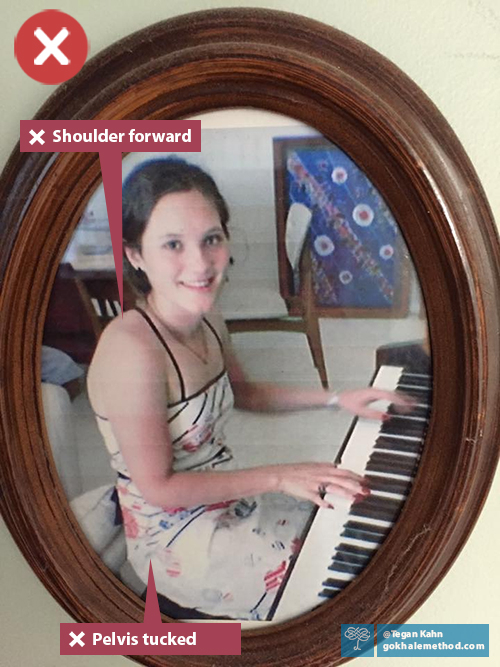
Me on New Year’s Day twenty years ago at age 16. Slouching was my default. I felt it was impossible to maintain “good” posture for more than a few minutes at a time.
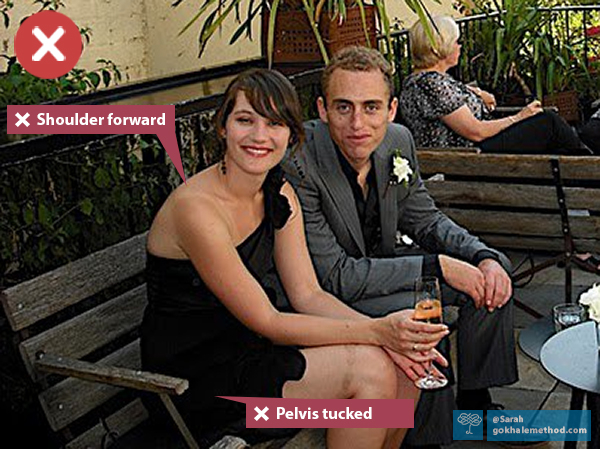
Me slouching at 22. Another beautiful dress spoilt by poor posture!
I used to experience all kinds of pain and dysfunction in my body: lower back pain, upper back strain, jaw tightness, shin splints, IT band tenderness, tight hamstrings, lactic acid buildup, and dodgy knees, to name a few. Even gentle massage on some parts of my body, such as the backs of my upper arms and lower legs, caused me to leap off the table.
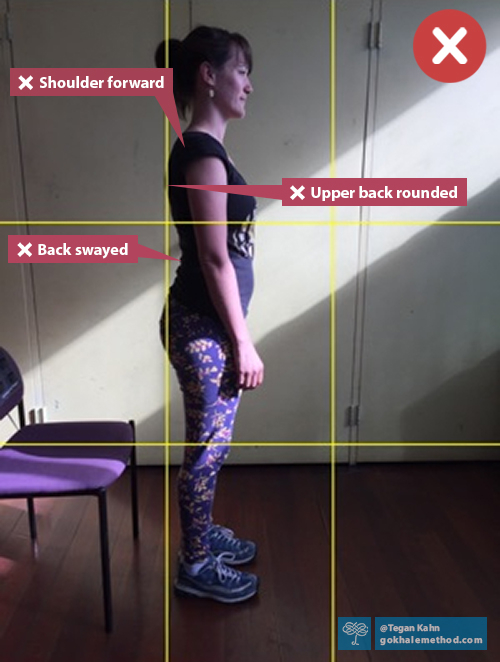
Despite attempting to stand up straight for this “before” photo, by the time I took the Gokhale Foundations Course in 2016 I was starting to develop a dowager’s hump (at the ripe old age of 28). I wonder what my posture would be like now had I continued on this trajectory.
One day when I was having my twice-weekly massage for typing-related forearm tendonitis (a repetitive strain injury covered by workers’ compensation), my massage therapist told me I had little crunchy crystals of lymphatic fluid along the lower left border of my rib cage. I had known for a long time that my lymphatic system was sluggish, but so slow-flowing that the fluid had crystallised was a bit of a wake-up call!
That discovery led me to tumble down the YouTube rabbit hole of lymph and fascia research, where I stumbled upon Esther Gokhale’s TEDxStanford talk. It is hard to overstate how great an impact that six-minute video has had on my life. The slide Esther presented showing a J-shaped spine next to an S-shaped spine blew my mind. I had studied anatomy at university during my biology degrees but it had never occurred to me that my textbooks might have been based on incorrect assumptions.
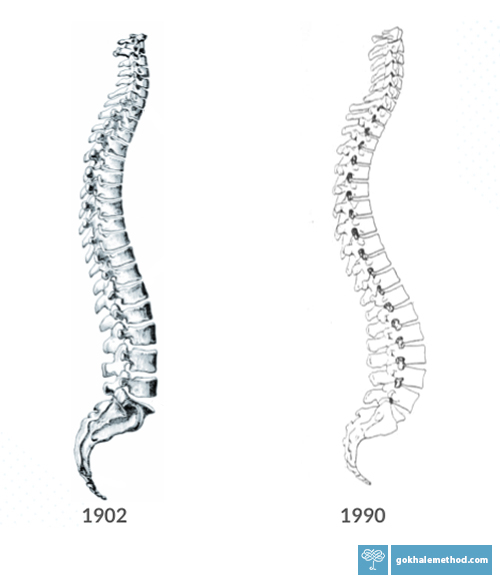
The illustration that immediately convinced me of the sound logic behind the Gokhale Method. If you’d like to learn more about it, consider reading our blog What Shape Is Your Spine?
The logic of Esther’s presentation was so arresting I felt a bit dumbfounded (and a touch indignant) that I had never heard this information before. I set about reading and watching anything Gokhale Method-related that I could get my hands on. I was extremely fortunate that the original, and only Gokhale Method Teacher in Australia at that time, Michelle Ball, was offering a Gokhale Foundations Course in my home city of Canberra a mere three months after I watched the TEDx talk. I felt like the stars were aligning.
I was already convinced by the theory and evidence basis of the Gokhale Method, but I was yet to see first-hand the ramifications of implementing it. My mum, who had been left with daily pain following a serious car accident before I was born, attended the Foundations Course with me. When she turned to me at the end of the first lesson and said, “this is the longest I've sat without pain in 30 years,” I was doubly sure that this was something I wanted to be involved with in a big way. In fact, Michelle may recall that even on that first day of the Course I was already asking her what the steps were for becoming a qualified Gokhale Method Teacher.
At that time, I was also struggling to find motivation to return to my job as a science writer for a university following my maternity leave—while my work had a worthwhile indirect impact, I was having trouble justifying being away from my little son to do work that wasn’t directly and palpably making a difference to people. Perhaps it was the sleep deprivation, or the deep well of support from my mum, that led to me booking the three of us (myself, mum, and my by-then-14-month-old) on flights to San Francisco to begin the week-long intensive training with Esther, the start of the qualifying process. Looking back, it seems kind of a crazy undertaking, but I’m glad I did it, as I’ve rarely been more sure of wanting to do something.
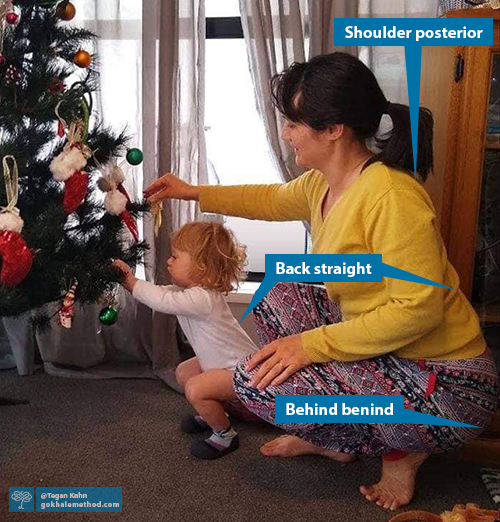
I feel extremely grateful to have gained the know-how to help preserve my kids’ naturally healthy posture. Although, with their J-spines still mostly intact, they are more often good posture role models for me than the other way around!
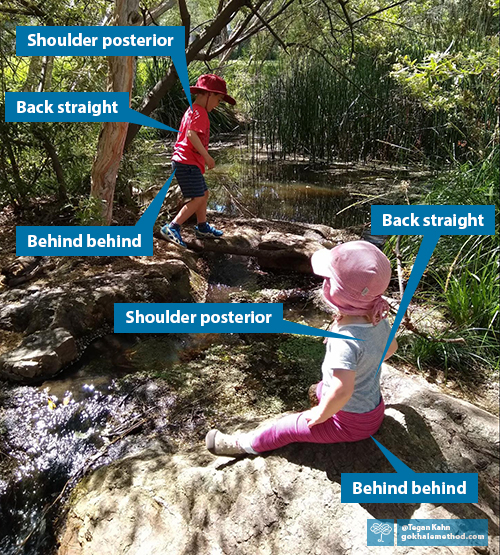
Training with Esther was bliss. I was so fortunate to be in company with the beyond lovely Kathleen O’Donohue and Tiffany Mann, my fellow trainees. Every day we explored a wide variety of subjects relating to teaching the method and then practised our new skills on a willing Foundations Course cohort. I just loved the depth and nuance that’s involved in rolling someone’s shoulders to just the right position for them (and of course seeing the change in their facial expression when they realised it was now easy and comfortable to maintain healthy shoulder architecture!). Esther’s knowledge and expertise were awe-inspiring, and it was a jam-packed journey. One day we toured the Cantor Arts Center at Stanford University, analysing the posture of the sculptures; the next day she ordered in some Chinese food for our lunch (and when she ordered over the phone in fluent Chinese, I thought: “of course Esther speaks Chinese—what can’t she do?”)
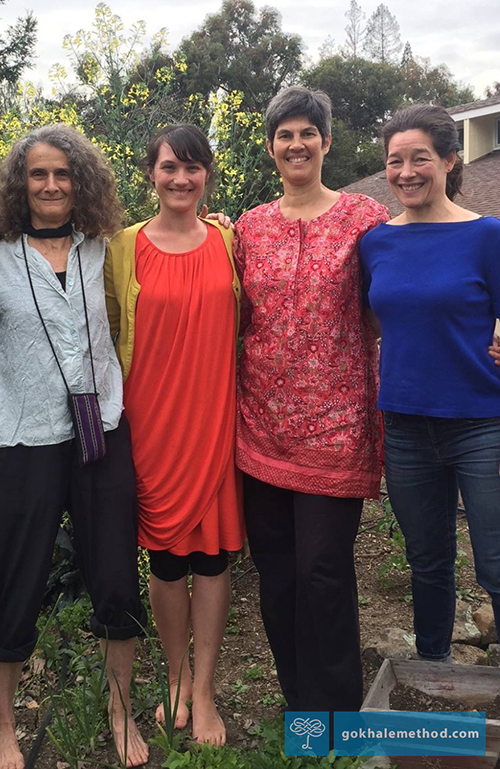
Myself (second from left), Esther (second from right), and my fellow teacher trainees Tiffany Mann (right), and Kathleen O’Donohue after practising our hip-hinging while picking kale in Esther’s garden.
When I returned to Canberra with my head full of knowledge, I leapt straight into my case studies (my husband was the first and patiently continues to be my guinea pig all these years later), and was proud to become a fully-fledged Gokhale Method Teacher once my peers and Esther had reviewed the videos of my teaching and given their valuable advice and support. My enjoyment of teaching hasn’t lost its lustre. I love interacting with people from all walks of life, adapting my teaching style and my hands-on help to their particular bodies and personalities. I love seeing them smiling in their “after” pictures (hardly anyone smiles in the “before” pics!), and am always on a high when someone tells me how the techniques have improved their lives, in little and big ways. Although I have passed through the initial uncertainty of my early teaching experiences (it can be hard to believe what you’re doing will produce astounding results when all the health information around you is based on an entirely different paradigm of healthy human spinal shapes), I still sometimes feel the need to “pinch myself” when a student makes a particularly marked transformation in their posture and pain levels.
I feel very privileged to be able to pass on this life-changing wisdom, and Michelle and I are excited to get this work to as many people who need us as we can. Some of our wonderful students have expressed interest in becoming Gokhale Method Teachers, too, and Esther is planning to come all the way to Australia to train them if there is enough interest. We wait to welcome them with open arms to work collaboratively on our mission to make back pain rare around the globe.
If you or someone you know are interested in hearing more about Gokhale Method teacher training with Esther Gokhale in Australia, please reach out to [email protected].
Best next action steps
If you are new to the Gokhale Method, get started by booking a consultation, online, or in person with one of our teachers to find out how the Gokhale Method can help you.
You can sign up below to join any one of our upcoming FREE Online Workshops. . .

Comments
Add New Comment
Login to add commment
Login